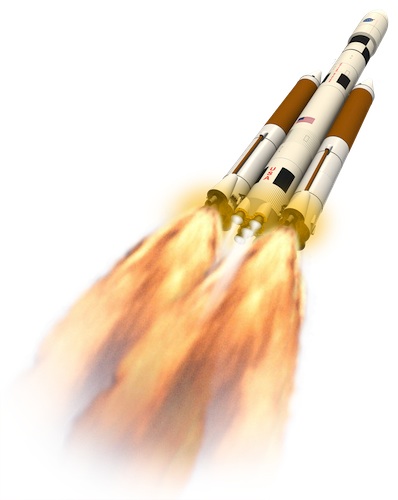FYI, Dynetics is the System Integrator for MOAB, and also for StratoLaunch, that huge air dropped Falcon Five that Paul G. Allen is heading up.
Link

WASHINGTON -- Dynetics and Pratt & Whitney Rocketdyne announced Wednesday they are teaming up to resurrect the Saturn 5 rocket's mighty F-1 engine to power NASA's planned heavy-lift launch vehicle, saying the Apollo-era engine will offer significantly more performance than solid-fueled boosters currently under development.
"The ability to come back and offer NASA a resurrection of probably one of the most venerated successful engines ever, the F-1, is very neat," said Steve Cook, director of space technologies at Dynetics Inc. "The cool factor on this is very high."
NASA plans to award $200 million to multiple companies later this year for 30 months of design and risk reduction work on advanced booster concepts for the agency's Space Launch System, a powerful heavy-lifting rocket designed to dispatch astronaut crews to deep space destinations, including asteroids, Mars, and the moon.
The 30-month performance period is expected to begin Oct. 1 and run through early 2015. The first two flights of the Space Launch System will be boosted off the launch pad by five-segment solid rocket motors built by ATK and derived from the space shuttle program.
NASA hopes a bigger booster will be ready by the third SLS flight in the early 2020s.
Dynetics of Huntsville, Ala., is leading the contractor team proposing the F-1 engine design. Pratt & Whitney Rocketdyne is the bid's propulsion partner and engine builder.
Cook, NASA's former manager of the scrapped Ares rocket program, said each of the two Dynetics boosters on an SLS mission would be propelled by a pair of kerosene-fueled F-1 engines.
"Each of those engines can get up to 1.8 million pounds of thrust," Cook said in an interview Wednesday. "This booster is a very simple, very standard booster. It's 18 feet in diameter. It uses the same attach points as the current five-segment solid rocket booster."
Pratt & Whitney is the prime contractor for the Space Launch System's core propulsion system, initially comprised of up to four hydrogen-fueled RS-25D/E engines. The cryogenic upper stage's J-2X engine, another redesigned engine from the Apollo moon program, is under development by NASA and Pratt & Whitney for SLS flights beginning in the 2020s.
The first two SLS missions, scheduled for 2017 and 2021, will be powered by an interim cryogenic upper stage, a four-engine core, and twin five-segment solid rocket boosters. The 2021 mission, planned to loop around the moon, will be the mammoth rocket's first crewed launch.
The earliest version of the Space Launch System will stand 30 stories tall and lift at least 70 metric tons, or 154,000 pounds, into low Earth orbit.
Subsequent long-duration missions to further destinations, such as asteroids or Mars, will require a more robust version of the Space Launch System using the J-2X engine and advanced boosters.
Along with the Dynetics and Pratt & Whitney team, ATK and other industrial contractors also submitted proposals for the advanced booster risk reduction awards.
"We're essentially flying out assets we have while we try to evolve to a more affordable and capable booster for the future," said Todd May, NASA's Space Launch System program manager, in an interview in February.
NASA plans a design and development contract for the advanced booster after the risk reduction phase ends in 2015.
Cook said the F-1 engine-powered advanced booster will provide about 20 metric tons, or 44,000 pounds, more lift capacity into low Earth orbit over the heavy-lift launcher's baseline solid rocket boosters.
"We offer a domestic booster design that takes advantage of the flight-proven Apollo-Saturn F-1, still the most powerful U.S. liquid rocket engine ever flown," said Ron Ramos, Pratt & Whitney Rocketdyne's vice president for exploration and missile defense. "PWR is the only company to have returned a Saturn-era engine, the J-2X, to production. We bring unique lessons to the advanced booster cost and performance trades."
Five F-1 engines flew on the first stage of each Saturn 5 rocket's upper stage. The Saturn 5 flew 13 times, launching astronauts to the moon and lofting NASA's Skylab space station into Earth orbit.
"That makes it one of the most reliable engines ever," Cook said. "You don't want to tinker with a design that you know works and has been successful."
Cook said the F-1 engine activities planned for the next 30 months, assuming Dynetics wins an award from NASA, include full-scale systems demonstrations and some hotfire testing.
The amount of progress depends on the level of funding provided by NASA, Cook said, adding the contractor team is already refurbishing some equipment with private capital.
"The risks associated with that [engine] were retired 40 years ago," Cook said. "What that allowed us to do was to focus our modifications and our changes around manufacturability, affordability and reliability. You take that engine and incorporate the lessons learned over the last 40 years of human, commercial and [military] spaceflight in propulsion systems, we think we can bring a very affordable package to the game. Largely, the design we're bringing is very similar or the same, and we've focused on manufacturability, bringing new processes and techniques that have been proven out."
"Cost wasn't a factor in the '60s," Cook said. "Cost is a huge factor today."
Link 2
Pratt & Whitney Rocketdyne and Dynetics have announced a resurrected F-1 engine as their entry into the advanced booster engineering demonstration and/or risk reduction (ABEDRR) programme, a precursor to selecting advanced boosters for the Space Launch System (SLS).
The liquid oxygen/kerosene-burning, gas-generator cycle engine produces more than 6,600kN (1.5 million lb) of thrust. Five such engines comprised the first stage of the Saturn V rocket, which launched the Apollo series of lunar exploration missions.
Development could cost half that of a clean-sheet booster design, says John Vilja, vice president of strategy at Rocketdyne. "Now that we have a design that has actually been proven, it's easier to just copy that."
Resurrection of the F-1, the most powerful engine built by a United States company (only the Russian RD-170 is slightly more powerful) has long been a topic of wistful discussion amongst rocketry circles.
"Every rocket designer that's ever come to us says, 'Boy, I wish we had an F-1,' because it solves a lot of problems," says John Vilja, vice president of strategy at Rocketdyne. "It's big thrust in a small space - relatively small."
The F-1 proposal will be submitted as a competitor to a NASA risk reduction contract. Selections, expected in October 2012, will be awarded to several companies. After further development and experimentation, NASA will down-select to a single booster for full-scale development.
Testing in the first phase will involve assembling a power pack, consisting of a complete gas generator and turbopump, for testing. Initially, testing may use leftover hardware from the F-1A programme, a 8,000kN-thrust variant of the engine that was built but never flown. The equipment is now around 40 years old.
"We have three of those that we're tearing apart right now, looking to see where we had galvanic corrosion, figuring out where we might have some things we want to change," says Vilja.
Rocketdyne believes a working powerpack can be assembled and tested by 2015, with additional parts under construction. If NASA selects the F-1 to become the SLS booster, The company believes it can assemble and test a full engine by 2017, and certify it for flight in 2020, in advance of SLS's planned 2021 flight.
The company took the same approach when it was tapped to build the SLS upper stage, the J-2X that is currently undergoing testing. The J-2X is an updated version of the J-2, which flew as the Saturn V's upper stage.
Competitors include Aerojet with the LOX/RP-1 AJ-1000, a significantly scaled-up version of its AJ-26 engine, and ATK's advanced solid rocket boosters.
Link 3
COLORADO SPRINGS, Colorado - Dynetics and Pratt & Whitney Rocketdyne have formed a long-term partnership to compete for the NASA Space Launch System Advanced Booster Engineering Demonstration and/or Risk Reduction procurement contract, the two companies said today.
Under the agreement, which was announced at the National Space Symposium, Huntsville-based Dynetics and Pratt & Whitney Rocketdyne are exclusive partners in using the Saturn V F-1 rocket engine technology.
"The SLS booster procurement requires a team that can balance affordability, innovation and experience throughout the life cycle - from development to production and operations," said Steve Cook, Dynetics director of space technologies. "Dynetics and PWR have formed such a team, offering a wide-ranging set of risk-reduction activities and demonstrations that enable a superior booster solution."
Leading the SLS team as project manager is Kimberly Doering, a 28-year aerospace veteran with 13 years' experience at NASA, including serving as deputy program manager of the Space Shuttle program. Doering most recently served as vice president of United Space Alliance's corporate business development and strategic planning, and vice president of Huntsville operations.
"We offer a domestic booster design that takes advantage of the flight-proven Apollo-Saturn F-1, still the most powerful U.S. liquid rocket engine ever flown," said Ron Ramos, Rocketdyne's vice president for Exploration and Missile Defense. "PWR is the only company to have returned a Saturn-era engine, the J-2X, to production. We bring unique lessons to the Advanced Booster cost and performance trades."
Link 4
UTC Closes In On PWR Sale
Apr 19, 2012
By Guy Norris
COLORADO SPRINGS — United Technologies Corp. (UTC) is expected to complete the sale of its Pratt & Whitney Rocketdyne rocket propulsion arm within the next two weeks as part of efforts to raise $3 billion to help finance its acquisition of Goodrich Corp.
Although the rocket maker declines to comment, Aviation Week understands final paperwork is in the process of being signed for the company’s sale to a private investment group. UTC originally put Pratt & Whitney Rocketdyne up for sale in 2011, and revived its offer in March following shareholder approval for the takeover of Goodrich on March 13.
Fellow U.S. rocket manufacturers Alliant Techsystems (ATK) and GenCorp’s Aerojet were originally thought to be the most likely potential bidders for PWR, which UTC bought from Boeing for $700 million in 2005. However, sources at the 28th National Space Symposium being held here tell Aviation Week that unnamed investors are in the process of clinching the deal.
The group believed to be most strongly linked to the acquisition is thought to involve Microsoft co-founder Paul Allen, former Scaled Composites CEO Burt Rutan and former NASA administrator Mike Griffin. The three are behind Stratolaunch Systems, the company founded in late 2011 to develop a next-generation, mobile, airborne launch system based on a hybrid aircraft formed from two Boeing 747s (Aerospace DAILY, Dec. 14). Another board member of Stratolaunch is Dave King, vice president of Dynetics, the Huntsville, Ala.-based company that will be responsible for integration of the launch vehicle and carrier aircraft systems.
Coincidently, Dynetics and PWR announced at the National Space Symposium a long-term partnership to compete for the NASA Space Launch System (SLS) Advanced Booster Engineering Demonstration and/or Risk Reduction (ABEDRR) procurement. Under this agreement, Dynetics and PWR will have exclusive rights to the use of the Saturn V F-1 rocket engine technology.
Sources close to the negotiations say that PWR does not require a partnership with an established propulsion company to fulfill its broader strategic objectives, and that work is going on to “disentangle” its operations from those of UTC. The challenge is hardest in West Palm Beach, Fla., where the rocket maker shares production and test facilities with those of main engine maker Pratt & Whitney, and helicopter manufacturer Sikorsky. PWR is understood to be exploring separate entrances to the swampland site as part of the process.
In California, PWR has been busy consolidating its Canoga Park sites close to Los Angeles as part of drastic cost-cutting moves in the wake of the retirement of the space shuttle in 2011. “Between now and 2013 we’ll cut the amount of fixed space in half, [where] the lion’s share of square footage is in California. We’ll be going from 2.1 million square feet to under 1 million square feet,” says PWR President Jim Maser.
----------------------
My own personal opinion? It'll come down to F-1A versus ATK's advanced SRB; because let's be honest; Aerojet has never once built a complete NK-33 engine -- all they've done is refurbish old Soviet engines with modern electronics and gimbal systems and change the nameplate to read AJ-26. Now they want to build a significantly upscaled version of the NK-33? Doesn't pass my technology readiness level smell test.
F-1A already has significant work done on it in the 1990s for George H.W. Bush's Space Exploration Initative (SEI) regarding a restart.
In the 1990s, Rocketdyne estimated that a F-1A Restart program would cost $315 million in FY92 dollars in non-recurring costs to restart production and re-certify the engine. Recurring costs would have been $1,080 million in FY92 dollars for 72 engines at an average cost of $15m FY92 dollars per engine, with deliveries over a five year period. Deliveries would have commenced four years after authority to proceed, with a peak delivery rate of 16 engines per year.
Link to 1994 F-1A Restart Costing
Basically, they worked out in 1994 what had to be replaced -- such as Beryllium and Cadmium alloys, which were no longer allowable under OSHA regulations along with Abestos, and stuff that just plain got obsolete, like Inconel X-750 and Hastelloy C.
The MK10A turbopump of the F-1A used TENS 50 aluminum in a number of castings. TENS 50 has beryllium at a level over 1994 OSHA standards. It would be replaced with A356 Aluminum or A357 Aluminum which uses beryllium in levels acceptable to OSHA.
This form of conversion was actually done in real life when Rocketdyne restarted Atlas and Delta engine production -- they had to convert the turbopumps/impellers/volutes from TENS 50 to A356/A357.
The abestos thermal insulation blanket used on the Apollo Era F-1s would simply be replaced with the same type of thermal blanket developed for the RS-27 engine restart.
Other changes such as producibility changes would have been implemented -- these were also done during the Atlas/Delta engine restart programs.
One such producibility enhancement would have been the LOX Dome. The original Apollo-Era design had sixty different details such as shell segments, pins, flanges, bosses, spacers, brackets, etc which all had to be individually machined and/or formed; then welded together -- all of which required a lot of joint preparation, fit up work, welding, inspection and rework as necessary.
Under the F-1A restart, the LOX Dome would have been changed to a single piece casting, eliminating all that.



 Commander of the MFS Darwinian Selection Method (sexual)
Commander of the MFS Darwinian Selection Method (sexual)